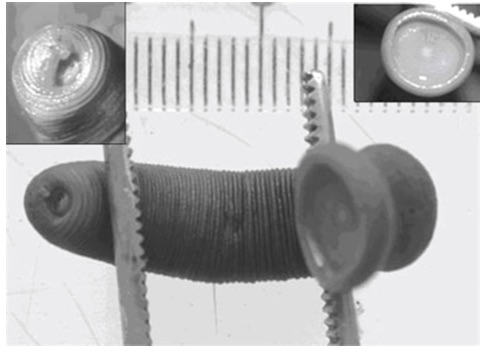עבודה זרה יב ,ב
ת"ר לא ישתה אדם מים לא מן הנהרות ולא מן האגמים לא בפיו ולא בידו אחת ואם שתה דמו בראשו מפני הסכנה מאי סכנה סכנת עלוקה
The Sages taught: A person should not drink water from rivers or from ponds either by drinking from the water directly with his mouth, or by collecting the water with one hand alone. And if he drank in this manner, his blood is upon his own head, due to the danger. What is this danger? It is the danger of swallowing a leech.
There are about 680 identified species of leeches (so far). Most are found in freshwater, and are found on every continent except Antarctica. You should stay away from them.
In western developed countries, our drinking supplies are safe to drink (mostly). But around the world leeches are still found in water that is used for human (and animal) consumption. Today's page of Talmud reminds us of the danger that leeches once imposed. That danger is still very much present.
The Nile Leech. And others
The Koren Talmud notes that one species of leech, the Nile leech (Limnatis nilotica) can still be found in bodies of water in Israel. Indeed leeches are found across the Middle East. Ten years ago, a case report was published in the Turkish Journal of Parasitology which described what happened when Limnatis nilotica got into the nose of a poor five year-old girl in Turkey.
“ The doctor who was trying to aspirate the blood in the patient’s mouth noticed the bloody formation moving slightly. This formation was removed by an otolaryngologist under local anesthesia and was brought to the parasitology laboratory and identified as a leech.”
The girl had nose bleeds and had vomited blood over three days. She required an urgent blood transfusion, and while trying to remove blood from the girl's nose the doctor "noticed the bloody formation moving slightly." The bloody moving formation was carefully removed and sent to the pathology laboratory where it was identified. It was a leech. Here is a picture of the villain:
Leech obtained from the case. From Agin, H. et al. Severe Anemia Due to the Pharyngeal Leech Limnatis nilotica in a Child. Türkiye Parazitoloji Dergisi, 32 (3): 247 - 248, 2008
This is certainly not an isolated incident. In fact, there are so many reports of leeches in the medical literature, that an Iranian group published a meta-analysis of leeches "as a live foreign body."
Selection of published literature on leech infestations. From Saki, N. et al. Meta Analysis of the Leech as a Live Foreign Body: Detection, Precaution and Treatment. Pakistan Journal of Biological Sciences 2009: 12 (24); 1556-1563
The more you read, the more the meta-analysis gets scary. Here is another table, detailing the 28 patients the Iranians had seen at their hospital in Ahwaz, Iran. (Fun fact about Ahwaz: in 2011 the World Health Organization declared it to be the most air-polluted city in the world. Ahwaz: If our leeches don't kill you, our air will.)
Detail of 28 leech infested patients seen over a ten year period at Ahwaz Jondishapour Universtiy of Medical Science, Ahwaz, Iran. From Saki, N. et al. Meta Analysis of the Leech as a Live Foreign Body: Detection, Precaution and Treatment. Pakistan Journal of Biological Sciences 2009: 12 (24); 1556-1563
The longest leech they found was a whopping 10 cm (over 4 inches) that had taken up residence in the back of the mouth. Why didn't the patient feel that massive creature? Well, leeches are crafty; they secrete an analgesic so the victim doesn't feel the bite. At most, you might feel a little wiggling.
Vinegar. Really?
Today's page of Talmud not only cautions us to be careful when drinking from a spring or river. It also suggests a treatment for leech attachment:
אמר רבי חנינא הבולע נימא של מים מותר להחם לו חמין בשבת ומעשה באחד שבלע נימא של מים והתיר רבי נחמיה להחם לו חמין בשבת אדהכי והכי אמר רב הונא בריה דרב יהושע ליגמע חלא
Rabbi Hanina says: In the case of one who swallows a water leech [nima], it is permitted to perform labor on Shabbat and heat water for him to drink on Shabbat, as his life is in danger. And in fact there was an incident involving one who swallowed a water leech, and Rabbi Neḥemya permitted them to heat water for him on Shabbat. In the meantime, until the water is ready, what should he do? Rav Huna, son of Rav Yehoshua, said: He should swallow vinegar.
As it turns out, Rav Huna's advice to drink vinegar can be found in today's medical literature. The Ahwaz team offers this suggestion:
If the leech is in the nares or upper pharynx, it be detached by applying 30% cocaine, 1:10,000 adrenalin or dimethyl phthalate to it. Another method is irrigation with strong saline, vinegar, turpentine or alcohol.
Rav Huna's treatment with vinegar seems to be supported in the medical literature. So next time you travel to Ahwaz, take some along with you.















